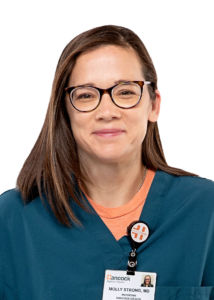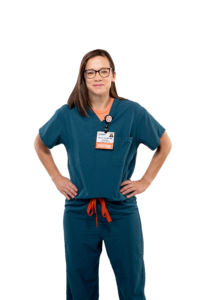
This story was created in partnership with Hancock Health.
As COVID-19 swept through the country in March 2020, the number of people seeking primary care subsequently declined. For the most part, it was because many hospitals suspended non-emergency services in an effort to slow the spread and keep healthy patients healthy.
However, as health care facilities slowly returned to semi-normal operations, many patients did not return for preventative care or screenings. This includes annual pap smears or mammograms, depending on a person’s age. Seeing a decline in visits is worrisome to doctors for many reasons, largely because it’s vital to maintaining good health.

“Preventative care is an important part of health maintenance,” said Dr. Molly Strong, MD, an OB/GYN at Hancock Health. “I think of it similar to brushing our teeth every day. It’s just a way of preventing a disease from becoming worse. It’s a way of finding disease early so it can be treated, and it’s a way of hopefully preventing illness.”
Dr. Strong gave us her thoughts on the importance of preventative care, why it declined during the pandemic, and why doctors’ offices truly are one of the safest places.
First, what is preventative care?
When it comes to preventative care, there are a number of routine exams and annual screenings a woman should get. These screenings are so vital because they test for several illnesses or diseases, including cancer. When caught early, there is usually a great chance of treating it and going into remission.
For starters, Dr. Strong recommends women get a “well woman exam” once a year.
“During that exam, we’ll do a breast and pelvic exam,” Dr. Strong said. “And we may do a pap smear. In addition to exams, we always talk about medications that the woman may be on, her diet, and her exercise habits. We talk a little bit about other lifestyle choices that could be beneficial to health or harmful to health.”
Something to not overlook when seeking preventative care is sexual health. Dr. Strong explains that with sexual health, there are a lot of parts that encompass it, such as your emotional and metabolic health. She also stresses that in general, women tend to care for other people, and as a result, put their own health on the back burner. So, Dr. Strong likes to also talk to her patients about how emotional health is often tied to sexual health, in addition to the importance of routine health maintenance.
“We may not be thinking about all of those components on a daily, weekly or even monthly basis,” she said. “We do screenings for diabetes and thyroid disease and other diseases that could affect your sexual health.”
Women ages 45-54 are recommended to get a mammogram once a year, according to Cancer.org. Women over the age of 21 are recommended to get pap smears once every three years to check for cervical cancer or human papillomavirus, according to the Centers for Disease Control and Prevention (CDC).
Why did people stop going to the doctor?
According to the CDC, about 41% of US adults delayed or avoided getting medical care by June 2020. This was largely due to many health care systems suspending non-emergency operations in an effort to slow the spread and allow for overwhelmed hospitals to care for the influx of COVID-19 patients. However, many patients continued to avoid preventative care throughout 2020 and into 2021, even as hospitals regained normal capacity.
A July 2021 study by JAMA Network further revealed that women specifically were 20-30% less likely to receive preventative services in 2020 compared to 2019. Of those avoiding or delaying care, the study shows that the decline was most pronounced among women with lower socioeconomic status and women of color, and the dip was due at least in part to increased disparities in access.
For patients that are able to find access to a doctor, there may also be difficulty in finding one that they can relate to, which can make them feel uncomfortable talking with a provider about health issues they may have.
“We in medicine are aware of this, and we’re continually working to make medicine more approachable, to create situations where people feel comfortable and maybe feel like they can trust the practitioner that they’re going to,” Dr. Strong said.
Another prominent reason why someone might be delaying care right now is because they are leading chaotic lives, whether it be working three jobs or being a primary caregiver.

“These women just don’t have time to come to a doctor’s appointment,” Dr. Strong said. “We see women that don’t have reliable transportation. So, there are all sorts of factors that play into it. I always think specific to that patient that I’m talking to because once you generalize it, you may be missing what’s really most important to that individual person.”
A unique approach to care that many providers adapted throughout the pandemic is virtual visits. Of course, these do have limitations because doctors aren’t able to do physical exams or screenings. But, virtual visits might be a viable option for individuals that might not have transportation to physically get to appointments or are still worried about going in person. Dr. Strong notes that virtual care has proved to be effective in making patients feel more comfortable talking with their physician.
“I have some patients who, for various reasons, feel more comfortable talking to me at home as opposed to coming into the office and that’s always an option,” Dr. Strong said. “We’ll try to do as much as we can in a virtual visit so that people can get care.”
Like many providers, Hancock Health has adapted its practices to the ongoing COVID pandemic. For instance, they are staggering patients and reducing capacity in waiting rooms. And much like before the pandemic, they are continuing to thoroughly disinfect rooms and instruments in-between use.
“We have made our office as safe as possible for patients,” Dr. Strong said. “It’s probably safer to go to your doctor’s office than to go to the grocery store. We just have so many plans in place to keep patients safe.”
Samantha Kupiainen is a regular Indy Maven contributor.
All of our content—including this article—is completely free. However, we’d love if you would please consider supporting our journalism with an Indy Maven membership.










